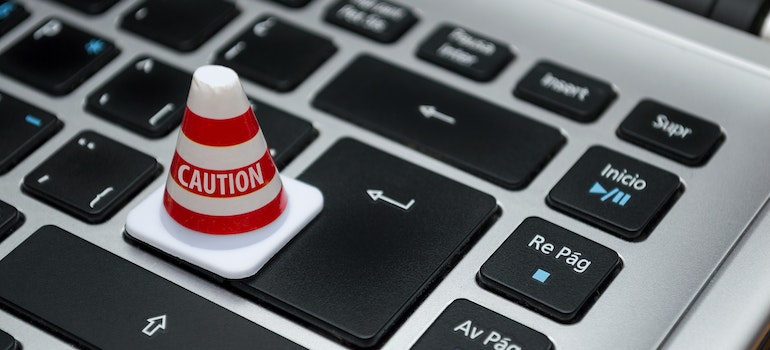Guide to Safeguarding Personal Information During Relocation
Data breaches, identity theft, and privacy invasions lurk around every corner, waiting for a chink in our protective armor. And while our heightened awareness generally circles around online activities, a life event as seemingly straightforward as relocating can inadvertently expose us to these perils. Moving home, whether for personal reasons or work, involves juggling countless tasks. Amidst the chaos of packing boxes, arranging logistics, and managing the emotional aspects of moving, safeguarding personal information during relocation often takes a backseat. But it shouldn’t. The risks are real. Therefore, the most trustworthy movers and packers Seattle has are here to explain how you can avoid them successfully.
Types of Personal Information at Risk
When we talk about personal information, we often think of our digital footprint. Yet, the threat isn’t confined to the digital sphere. Let’s break it down:
- Physical Documents: Think of the myriad of papers you’ve accumulated over the years. Birth certificates, which serve as proof of your identity; tax records with intimate details of your financial landscape; bank statements that reveal your spending patterns, and more.
- Digital Data: Our dependence on technology means we carry our world in our devices. Laptops and hard drives store work data, personal photos, and often saved passwords. Meanwhile, mobile devices are crucial for both personal and work communications.
- Mail and Address-related Information: Beyond the packages and letters, our mail often carries sensitive information such as bank correspondences, utility bills, and medical records.
These details paint a picture of our lives, routines, and preferences and thus require utmost protection efforts.
Before the Move: A Blueprint for Safeguarding Your Data
Now that we understand the gravity and breadth of the situation, how can we bulletproof our personal information during a move? Here’s a roadmap to follow before you hire reliable moving services Seattle locals recommend.

Inventory of Sensitive Documents
Begin by knowing what you have. Create a meticulous checklist of all essential documents. The passport that has seen you through journeys, the social security card, which is foundational to many services in the U.S., tax records that are a testament to your financial discipline, and more. Knowing what you have is the first step in ensuring its safety.
Declutter with Purpose
Over the years, it’s natural to amass documents that no longer serve a purpose. Now’s the perfect time to declutter. But discard responsibly. Use a cross-cut shredder that reduces papers to confetti, making them almost impossible to piece together. For larger volumes, consider hiring a trusted document destruction service.
Backup Digital Data
As the saying goes, it’s better to be safe than sorry. Back up all your digital data. Use external drives for a physical copy, and consider cloud storage for remote access. However, always encrypt sensitive files. Encryption converts your data into a code, thwarting unauthorized access.
Update Software
Our devices are only as strong as their latest update. Software developers continually enhance security features and patch vulnerabilities. Ensure all your devices, especially those holding sensitive data, are updated with the latest security patches. This acts as a digital fortress, warding off the most common threats.
Packing Tips for Data Security
The boxes are piling up, the moving date looms closer, and amidst the hustle, it’s imperative not to overlook the safety of your personal information. Packing wisely, both for Seattle storage and moving, can mean the difference between a smooth transition and a nightmare of lost or compromised data. And while your belongings’ physical safety is paramount, ensuring they’re in trustworthy hands is equally vital. Here are some invaluable tips to navigate these aspects of your move.
Specialized Containers
Not all containers are created equal. For sensitive documents and essential gadgets, consider using specialized, lockable containers. These offer an extra layer of protection against prying eyes and ensure that even if a box goes missing or is tampered with, accessing its contents isn’t straightforward. Such containers can be hard cases with padlocks or boxes that come with built-in locks.
Label Discreetly
While it’s tempting to label boxes for easy unpacking, the first rule of safeguarding personal information during relocation is to avoid explicit labels like “Bank Documents” or “Personal Files.” These are beacons for those with ill intentions. Instead, use coded labels or vague descriptions that only you (or your family) can decipher. For instance, “BD” for bank documents or a color-coding system where a blue dot might mean personal documents.

Keep Essentials Close
There are some documents and items so vital that the mere thought of them going astray is unsettling. Passports, birth certificates, immediate financial documents, and critical digital devices fall into this category. Instead of packing these away, the most reputable portabox storage Seattle experts advise you to retain a personal bag or folder that stays with you throughout the move. This ensures immediate access and reduces the risk of misplacement.
Choosing a Reputable Moving Company: Trust but Verify
The moving company you choose plays a pivotal role in the safety of your belongings. It’s not just about their ability to handle boxes without breaking them; it’s also about entrusting them with access to your personal world. Here’s how to make an informed choice.
Research Potential Movers
Start by gathering a list of potential Washington movers. Dive into online reviews, but don’t stop there. Check ratings on the Better Business Bureau (BBB), which offers insights into a business’s history, including any complaints. Word of mouth is golden; ask friends or family for recommendations based on their experiences.
Inquire About Data Protection Policies
While movers are experienced in handling furniture and boxes, how adept are they with sensitive data? This might seem like an odd question, but with the increasing emphasis on data security, it’s a pertinent one. Ask potential movers about their policies on data protection. Do they offer specialized services for moving sensitive documents or electronics? How well-trained is their personnel in handling such items?
Understand Your Rights and Responsibilities
This is especially crucial if you’re moving between states with cross-country movers Seattle provides. Different jurisdictions can have varying rules regarding moving and the responsibilities of both parties involved. Familiarize yourself with your rights, any insurance coverages, and the mover’s liabilities. For interstate moves in the U.S., movers are required to provide you with a copy of the booklet “Your Rights and Responsibilities When You Move.” It’s a treasure trove of essential information.
Finally, the steps you take in packing and choosing the right moving company will go a long way in ensuring the move is not only smooth but also secure. Your peace of mind is worth the effort.

Steps for Safeguarding Personal Information During Relocation Day
The day has arrived. Boxes are taped up, movers are scheduled, and there’s an air of anticipation. Amidst the flurry of activities, ensuring the protection of personal data should remain paramount. Concurrently, the transition of your mailing address requires due diligence to ensure no vital communication slips through the cracks.
Supervise the Loading Process
Entrusting your chosen local movers in Seattle with your belongings doesn’t mean relinquishing supervision. Be present and proactive. Keep a keen eye, especially on boxes or items containing sensitive information. Ensure they’re handled with care and are loaded securely. If certain boxes or bags are to remain with you for personal transport, clearly communicate this to the movers.
Protect Your Devices
Our electronic devices often contain a wealth of information, making them prime targets for data theft. Before handing them off or packing them:
- Turn them off to prevent accidental usage or damage.
- Ensure they are password-protected. This provides an initial line of defense against unauthorized access.
- If possible, enable tracking features like “Find My Device” for added security.
The day of the move can be a whirlwind, but with a little foresight, you can ensure that your personal information stays safe every step of the way.
Securing Your Mail and Address Transition
Mail and address-related details can often be overlooked during a move. Yet, these can be treasure troves of personal information, and ensuring their security is paramount.
Change of Address
One of the first steps in any move should be to inform the post office of your change of address. This ensures a smoother transition of your mail. But don’t stop there. Your bank, insurance providers, utilities, subscriptions, and other essential services need to be updated about your new address. This not only ensures continuous service but also means sensitive information isn’t sent to an old address where it could be intercepted.
Consider Mail Forwarding
The post office offers mail forwarding services, which can be a boon during transitions. This ensures that any mail sent to your old address is automatically forwarded to your new one. It’s a safety net, ensuring you don’t miss out on vital communications during the initial days after the move.

Check with Previous Landlord/Neighbors
Despite all precautions, there might be occasions when mail trickles into your old address. This could be due to late notifications, oversight, or senders not updating their records promptly. In such cases, maintaining a good rapport with your previous landlord or neighbors can be beneficial. Ask them to keep an eye out for any mail or packages delivered in your name. They can either forward it to you or hold it for collection. It’s an added layer of reassurance, ensuring no important document gets lost or falls into the wrong hands.
Data Safety Post-Move
The actual act of moving can be so all-consuming that what comes after might seem like a breeze. But when it comes to personal data protection, the process doesn’t end once you’ve unpacked those boxes in your new home. The subsequent steps can be just as vital in ensuring the continued safety of your personal information.
Secure Storage for Sensitive Documents
Even within the confines of your new home, it’s wise to have a dedicated, secure space for important documents and devices. Consider investing in a fireproof and waterproof safe. It serves a dual purpose: safeguarding items from potential prying eyes and providing protection against unforeseen calamities.
Digital Network Safety
As you set up your internet and home network, ensure it’s secure. This includes:
- Setting a robust, unique password for your Wi-Fi network.
- Disabling open guest networks unless absolutely necessary.
- Regularly updating router firmware to patch vulnerabilities.
So, as you initiate this new life chapter, be it a move across town or to a different continent, let safeguarding personal information during relocation be a priority. With foresight and preparation, you can make your move both smooth and secure.
Home Security
While this might seem a departure from the theme of ‘data,’ home security can directly impact data safety. For instance, a break-in could result in the loss of devices containing personal data. Consider investing in home security systems or surveillance cameras. If you’re renting, enquire about the security measures in place and suggest improvements if needed.

Continuous Vigilance
In the digital age, our data forms a significant part of our identity. Its protection is more than a mere logistical consideration but a continuous effort.
Regular Data Backups
Establish a routine to back up your digital data periodically. This could be to external drives, cloud storage, or both. This is an excellent way to safeguard against data loss from device malfunctions or unforeseen incidents.
Stay Updated on Data Security
The world of data security is ever-evolving. It’s beneficial to stay informed about the latest threats and protective measures. Subscribe to reliable tech news sources or cybersecurity blogs.
Shred, Don’t Just Discard
As you continue living in your new space, the cycle of accumulating documents will persist. When discarding, remember the lessons from the move: always shred sensitive documents instead of simply tossing them in the trash.
A New Beginning, Safeguarded Against the Unexpected
As you can see, there is a common thread throughout this guide. It is a call for proactive responsibility through the lens of data security. Hence, while the tangible act of relocating from one space to another is evident, there’s an underlying theme that runs deep: safeguarding personal information during relocation. So, if you implement the preparatory phase, the moving day, and post-move considerations, you’re on a good way to protect your sensitive information long-term. Moreover, you will also craft an environment where your focus can be on the joy of settling into a new space, meeting new neighbors, and exploring new horizons with peace of mind.
Why Choose Us
History
Hansen Bros. Moving & Storage is locally owned and operated by the same family for four generations, since 1890. We have a well-established reputation for service quality and reliability with a high percentage of repeat household and commercial clients.
Professionalism
We’re a certified ProMover by the American Moving and Storage Association with A+ rating with the Better Business Bureau, voted “Best in Western Washington” in 2009 and from 2011 to 2016 by KING5. Our company is fully licensed and insured and member of WMC and AMSA.
Value
Hansen Bros. Moving & Storage provide free, no-obligation in-home estimate and competitive rates, including low minimum rates for shipments moving under 300 miles. We’ve set a refund policy for unused packing materials and three Puget Sound locations to help clients save on travel fee costs.



